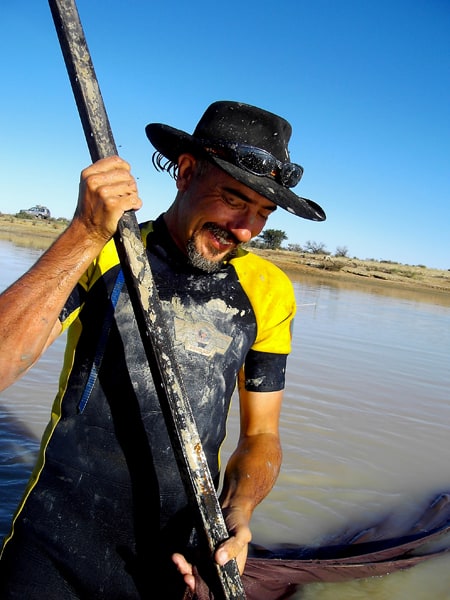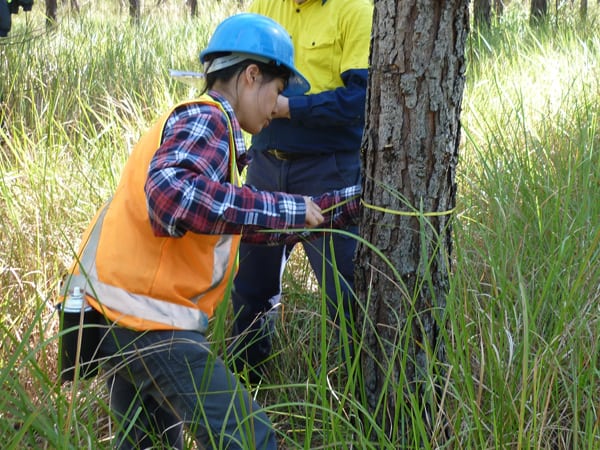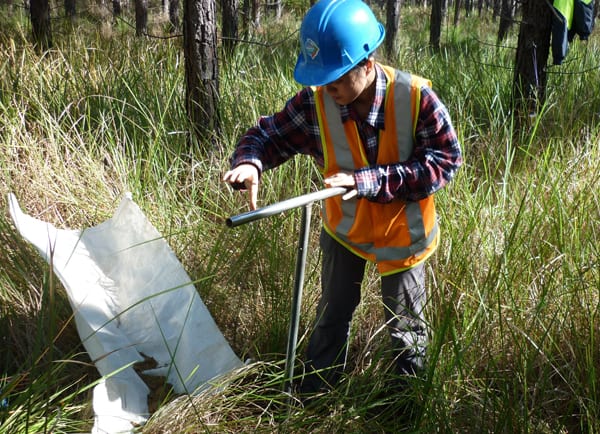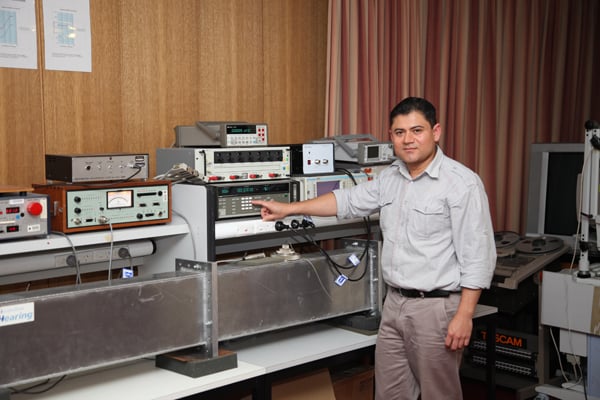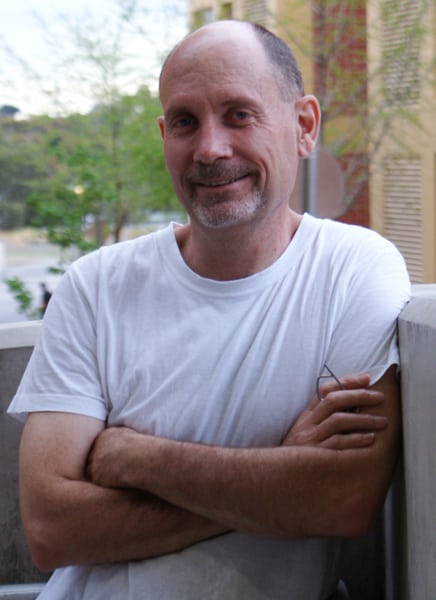The CRC Association is proposing a whole‐of‐government approach to cooperative research, with a much needed update of the Cooperative Research Centres (CRC) Program. Through this update the CRC Association is seeking to help build national capacity to improve productivity through enhanced innovation. The update involves positive design improvements to the CRC Program with an additional commitment of $250 million over five years. The additional commitment will be about half of 1% of the expected $50 billion that the Australian Government will invest in innovation over this period.
Year: 2011
2011 Ralph Slatyer Address on Science and Society
Professor Alan Robson AM
Vice-Chancellor, The University of Western Australia
Swimming with the desert fishes good news for Murray Darling
The desert is probably the last place on Earth you’d expect to see a fish. But Dr Adam Kerezsy of the eWater Cooperative Research Centre knows better; he has recorded more than 40,000 desert fish and says the information gleaned may bring good news for the wildlife of the Murray Darling Basin.
The Mulligan River is normally a sandy gully that marks the north-eastern edge of the Simpson Desert. But a couple of times a decade, the Mulligan briefly becomes a ‘real’ river, replete with water and, remarkably, fish.
Dr Kerezsy has found that as this watery gateway opens, up to 11 fish species are likely to take their chances and migrate upstream into the driest part of Australia and a very uncertain future.
“These rivers are highly unpredictable,” he says. “You’ll get a big flow one year and then you might not have another for five years. What’s amazing is these fish species are so well adapted to our unpredictable continent that it doesn’t really matter if you have 10 dry years in a row – they’ll survive it.”
Dr Kerezsy believes the key to these battlers’ survival is being ready to take advantage of opportunities when they appear.
“Although a few species breed regularly during the year, I found the vast majority breed all the time. This means they’ve always got juveniles around ready to capitalise on unpredictable rainfall.”
Dr Kerezsy says this finding alters how we used to think Australian animals adapt to highly variable environments and that it’s good news for the “broken” Murray Darling Basin.
“This finding is encouraging because it means if we can stop making things worse in the Murray Darling Basin, the animals there will probably be tough enough to recover.”
Dr Kerezsy says he was driven to look at desert rivers by the idea that “everyone’s researching the Murray Darling Basin, but I thought, ‘Hold on, if we keep looking at the problem maybe we won’t see the solution’.”
“Because these desert rivers haven’t been touched by humans, we can use them as a ‘natural lab’ to find out how Australian rivers are supposed to work and relate that information back.”
Dr Kerezsy’s new book Desert Fishing Lessons: Adventures in Australian rivers (UWAP) is out on 1st October.
Contact information
Dr Adam Kerezsy
Mobile: 0429 981 062
Email: a.kerezsy@griffith.edu.au
Professor Angela Arthington
Phone: (07) 3735 7403
Email: a.arthington@griffith.edu.au
eWater Cooperative Research Centre www.ewater.com.au
[Right click on photos to save them to your computer.]
Dr Adam Kerezsy holds a healthy Yellowbelly from the Diamantina River in far western Queensland. (Photo: Michael Brigden)
Setting nets at a rarely flooded waterhole in the eastern dunefields of the Simpson Desert. (Photo: Michael Brigden).
Virtual crash test takes crash out of landing
Mathew Joosten crash tests several helicopters a day, but he’s not daunted by this daring pastime – he uses computer simulation. As a research student of the Cooperative Research Centre for Advanced Composite Structures, Mr Joosten has designed a ‘virtual crash test’ that will help accelerate the development of next-generation safety systems.
Recent helicopter accidents have received significant public attention in Australia. In an effort to improve helicopter safety, manufactures are using advanced composite materials.
Advanced composite materials can be used to absorb vast amounts of energy in a crash, working in the same way as a crumple zone in a car, while being much lighter and more compact. “Beneath the seats of a helicopter we can install energy absorption devices that help absorb the impact of a crash, so that less is transmitted to the passengers,” says Mr Joosten.
Before composites can be used, extensive effort in designing and testing of these crash structures is required. “Composite structures absorb the energy of a crash by collapsing under a certain pressure,” says Mr Joosten. “We can design the ‘trigger’ to initiate the collapse by cutting through one or more layers to create a weak spot.”
“Up until now we have not been able to model these collapses with the accuracy required,” says Mr Joosten. “Without a computer model, assessing the performance of energy absorbing structures requires time consuming and expensive crash tests.”
With the support of the Cooperative Research Centre for Advanced Composite Structures, Mr Joosten has designed a new computer model to predict the ‘crashworthiness’ of energy absorption devices that will help in the design of safer structures.
“We now have a tool to predict the performance of energy absorbing structures with only a minimal number of real-life tests needed. This is great because it means that if the design is changed slightly, we don’t have to perform another time consuming and costly test.”
Although his model focuses on helicopters, Mr Joosten says it can be applied to many other aircraft.
“The model I’ve developed will allow aircraft designers to produce the best energy absorbing structural configuration to deliver improved occupant safety. Literally hundreds of different designs can be trialled to see which best protects passengers in a range of different crash scenarios.”
During the development of the new model, Mr Joosten spent several months conducting crash tests at the German Aerospace Center. He says the opportunity to work with leading experts all over the world is what affiliation with a Cooperative Research Centre is all about.
Contact information
Mr Mathew Joosten
Phone: (03) 8645 0452
Mobile: 0400 043 270
Email: m.joosten@student.unsw.edu.au
Dr Andrew Beehag
Utilisation and IP Manager
Cooperative Research Centre for Advanced Composite Structures
Phone: (02) 9772 8486
Mobile: 0400 827 016
Email: a.beehag@crc-acs.com.au
Cooperative Research Centre for Advanced Composite Structures
www.crc-acs.com.au
[Right click on photos to save to your computer.]
Mr Mathew Joosten, Cooperative Research Centre for Advanced Composite Structures
Measuring up for a sustainable future
PhD student Jie-Lian Beh is using a surprisingly simple tool to help improve the productivity and sustainability of Australia’s plantation forests. With the help of a measuring tape, she has developed a quick and easy new way to help manage this important Australian resource.
Most wood used to build and furnish Australian homes comes from plantation forests. Better management of these forests requires consideration of fine-scale variation in soil quality across a site, says Ms Beh.
“Historically, plantation sites have been managed on a coarse scale, separated into soil quality classes that are tens of hectares in extent,” says Ms Beh. “But this overlooks the finer-scale differences in soil quality typical of most plantation sites. Improvements in our understanding of soil properties are moving us towards managing forests almost at the level of an individual tree.”
Knowing how much soil lies beneath a tree provides vital knowledge about how much water, nutrients and space is available for growth. “This knowledge allows us to decide how many trees to plant, or how much fertiliser is needed on a particular site,” says Ms Beh.
But the current method of fine-scale soil sampling isn’t feasible for Australia’s two million hectares of plantation forests, says Ms Beh. “The usual method of mapping soil properties – getting a shovel and digging down – is extremely labour and time intensive, which means it’s incredibly expensive.”
A computer model developed by Ms Beh can predict soil depth at a fraction of the cost of the current method, simply by measuring the shape of existing tree trunks in the plantation – this is where the measuring tape comes in.
She hopes her model will lead to more sustainable management strategies that avoid depletion of soil resources.
“Building roads and bringing in heavy machinery during harvesting causes damage to the soil. This model allows us to say: ‘That road should be built 100 metres to the north, where the soil can better handle high traffic’.”
Ms Beh’s model was developed in collaboration with the Cooperative Research Centre (CRC) for Forestry, the CSIRO, State Forests NSW, and the Australian National University.
Affiliation with a CRC gives students an invaluable opportunity to work with people in industry, says Ms Beh. “I wanted to maintain a connection with the real world. You could discover something really useful, but if you don’t collaborate with people in industry, it might never get out there.”
Contact information
Ms Jie-Lian Beh
Phone: (02) 6125 2583
Mobile: 0433 770 384
Skype: Jie-Lian
Email: jie-lian.beh@anu.edu.au
Professor Peter Kanowski
Phone: (02) 6125 2667
Mobile: 0416 249 004
Email: peter.kanowski@anu.edu.au
Cooperative Research Centre for Forestry www.crcforestry.com.au
[Right click on photos to save to your computer.]
Ms Jie-Lian Beh measuring a tree trunk.
Ms Jie-Lian Beh digging.
New invention to protect iPod Generation ears
How loud do you have your iPod? If you couldn’t hear the question, you may be interested in a new way of processing sound invented by Dr Jorge Mejia of the HEARing Cooperative Research Centre (HEARing CRC).
‘Binge Listening’, a recent report by the National Acoustic Laboratories found that many young people are at risk of hearing loss from exposure to high-intensity music. Dr Mejia says his new technology can improve sound clarity while simultaneously protecting our ears from noise damage.
“People are exposing themselves to excessive noise – when they go to nightclubs or listen to loud music – that is damaging their hearing,” says Dr Mejia. “This technology will allow you to hear a friend talking in a nightclub clearly and at the same time protect your ears from other noises around you.”
Dr Mejia says that hearing aids incorporating this new technology will enable many hearing-impaired people to actually hear better than normal listeners in noisy environments. “They will work so well, people with normal hearing will want one,” he says.
Currently-available noise reduction technology is not sufficient for hearing-impaired listeners, says Dr Mejia, because it removes listeners’ ability to locate where sounds are coming from and to separate speech sounds from background noise.
“Communication is beyond hearing; it’s about interaction. This is a classical ‘cocktail party’ problem where your friends are all talking at the same time and you want to know who’s speaking and hear what they’re saying.”
Dr Mejia’s invention provides five times better speech clarity in noisy environments than current technology, without disrupting essential localisation cues.
The technology, which has been patented by the HEARing CRC, is expected to be available for application in hearing aids, hearing protection, iPods and other listening devices over the next two to four years.
“My goal is to enable everyone to hear as effectively as everyone else,” says
Dr Mejia, who believes a CRC is a unique environment in which to fulfil this ambition.
“A CRC, with its marriage of academic and commercial interests, is a unique organisation with respect to science in Australia,” says Dr Mejia. “CRCs have the capacity to bring basic research into fruition and make a real world difference.”
Contact information
Dr Jorge Mejia
Phone: (02) 9412 6873
Mobile: 0435132991
Skype: jorge.mejia19
Email: jorge.mejia@nal.gov.au
Professor Robert Cowan
Chief Executive Officer
The HEARing CRC
Phone: (03) 9035 5346
Mobile: 0418 780 198
Email: rcowan@hearingcrc.org
HEARing Cooperative Research Centre www.hearingcrc.org
[Right click on photo to save to your computer.]
Dr Jorge Mejia
Aboriginal public servants undervalued
Many Aboriginal public servants feel they are under-recognised and under-valued, according to recent research by the Desert Knowledge Cooperative Research Centre.
Dr Elizabeth Ganter, who interviewed 76 current or former Aboriginal employees of the Northern Territory Government about their experiences representing their people through employment, says her research yields some important messages for government.
“While the government invites Aboriginal participation up to the highest levels, I found that many Aboriginal public servants feel like ‘indigenous statistics’, valued more for their numbers than for their contributions to policies and programs,” she says.
Although Aboriginal people are 30% of the Northern Territory population, Aboriginal employment levels in the Northern Territory public service have hovered around 8% for the last 25 years, says Dr Ganter. As part of the national ‘Closing the Gap’ policy, the Northern Territory Government is aiming to increase that figure to 10% by next year.
“My research shows that Aboriginal people are entering government, but few rise to seniority. Many leave to work in Indigenous organisations,” says Dr Ganter. “What they had to offer didn’t easily find a place in their department.”
“My message to the government is: start by keeping the people you’ve got. Value their knowledge and connections. It’s all very well to attract people at entry level, but you need to create working environments in which Aboriginal people want to stay.”
“A couple of people said that my interview was the exit interview they had never had.”
One comment, from a senior public servant, stood out in particular to Dr Ganter. “This person asked of the public service: ‘How can you make decisions about Aboriginal people when you can’t even talk to the people you’ve got here?’”
Dr Ganter stresses that the government needs to realise the significance of the invitation it extends to Aboriginal people.
While her research focused on the Northern Territory Government, Dr Ganter says her findings are applicable to any public institution seeking Indigenous participation. She says the public service is showing interest in her research.
While Dr Ganter is herself a Northern Territory public servant and her research had the government’s support, she conducted it independently while on leave without pay.
As the sole instigator of the study, Dr Ganter received funding from the Desert Knowledge Cooperative Research Centre, whose philosophy, she says, is to conduct desert research by engaging with the people who live and work there.
Contact information
Dr Elizabeth Ganter
Mobile: 0400 124 639
Skype: elizabeth.ganter
Email: Elizabeth.ganter@alumni.anu.edu.au
Desert Knowledge Cooperative Research Centre www.desertknowledgecrc.com.au
Jan Ferguson
Managing Director, NintiOne Ltd
Phone: 0401 719 882
Mobile: 0419 331 119
Email: jan.ferguson@nintione.com.au
[Right click on photo to save to your computer.]
Dr Elizabeth Ganter
Asbestos identification for better public protection
The current way we measure asbestos in the air may be inadequate to protect the public from long-term, low-level exposure, says Mr Mike van Alphen of the Cooperative Research Centre for Contamination Assessment and Remediation of the Environment (CRC CARE).
The key to allowing more accurate identification of the public health risks posed by asbestos could be held by research aimed at characterising different asbestos minerals, currently being undertaken by Mr van Alphen at the University of South Australia.
This research focuses on identifying the specific nature of different asbestos types, their physical characteristics and potential health risks, as well as priority areas for further research.
Mr van Alphen says that more sensitive monitoring methods need to be implemented to monitor exposure scenarios, along with establishing an agreed level of acceptable risk for the public – something his research could play a vital part in.
“There are potential exposure settings where we need more sensitive monitoring methods simply to know whether they are high-risk or not,” he says.
“For example, it would be pretty rare to find a house built between the 1930s and the 1980s that doesn’t contain asbestos. Vinyl floor sheeting in these houses, for example, may be backed with felt-like asbestos that could easily become damaged and liberate asbestos into the air.”
Mr van Alphen says that a single large asbestos fibre bundle as typically found in asbestos cement could theoretically generate 50,000 million needle-like fibres that can be breathed into the lungs where they can pierce cells and cause disease.
He says that although it is commonly believed that blue asbestos poses a higher risk than white, regulators treat all types of asbestos as if they pose the same risk.
“It’s important to understand the variations between asbestos minerals and that these differences could be related to the ultimate health risks.”
Mr van Alphen’s work has also revealed that it may be possible to ‘fingerprint’ asbestos to discover which mine it came from. This may have important implications in lawsuits and hazard management, he says.
Contact information
Mr Mike van Alphen
Phone: (08) 8302 3172
Mobile: 0414 326 529
Skype: mikevanalphen
Email: mike.vanalphen@unisa.edu.au
Professor Andrea Gerson
Phone: 0422 112 516
Email: andrea.gerson@unisa.edu.au
CRC CARE www.crccare.com
[Right click on photos to save to your computer.]
Asbestos
Mr Mike van Alphen
Enviro-metal solves helicopter corrosion
PhD student Parama Banerjee at the CAST Cooperative Research Centre has developed a cheap and environmentally friendly alternative to the toxic coating currently used in Australian naval helicopters.
The magnesium alloy used to house the gearbox of Royal Australian Navy SeaHawk helicopters is prone to severe corrosion in marine environments, costing millions of dollars in maintenance every year.
To protect the alloy from corrosion, it is covered with a chrome-based coating that is toxic to humans and the environment.
Under joint supervision of the Defence Science and Technology Organisation (DSTO) and researchers at Monash and Swinburne Universities, Ms Banerjee has developed a much-needed non-toxic alternative made from an environmentally friendly material called silane, which provides superior corrosion protection.
“The silane coating is completely biodegradable and non-toxic so people can handle it safely. It also delivers the maximum corrosion resistance ever achieved for magnesium alloys.”
Ms Banerjee says while the new technology is still in a preliminary stage, it may be used to repair the corroded gearbox housings of SeaHawk helicopters in the near future.
DSTO was working with the CAST Cooperative Research Centre – which specialises in industry-driven research into metals technology, to address corrosion issues for magnesium alloys. The coating developed by Ms Banerjee was the result of the collaboration between the two organisations.
Ms Banerjee says the CAST Cooperative Research Centre works “hand-in-hand” with DTSO to ensure the research is meeting their needs.
“We have regular meetings with our collaborators at DTSO. We want to ensure they are satisfied with what we are developing,” she says. “Being part of a Cooperative Research Centre is all about thinking about the science and the real-world applications at the same time.”
“My passion is to develop technologies that will benefit our civilisation. This research has taken an important step towards a greener world.”
Ms Banerjee was chosen as one of eight early career researchers to speak about her research at the Cooperative Research Centre Association conference in Brisbane this week. She says being involved in a Cooperative Research Centre has transformed her “from a shy girl to someone who can confidently speak in front of any crowd”.
Contact information
Ms Parama Banerjee
Phone: (03) 9905 5173
Skype: parama.banerjee2
Email: parama.banerjee@monash.edu
Ms Sue Keay
Manager, Communication, Business Development & Training
CAST CRC
Phone: (07) 3365 3675
Email: s.keay@cast.org.au
CAST Cooperative Research Centre www.cast.org.au
Milk may help prevent gum disease
Current treatments for gum disease are expensive and painful. But now Dr Elena Toh of the Oral Health Cooperative Research Centre has discovered in milk the key to a new low cost, pain-free solution that may help prevent the disease.
Up to 30% of Australians experience serious gum disease. This nasty bacterial infection causes bleeding, swollen gums and bad breath. It is a major cause of tooth loss and has been linked to increased risk of other health problems including heart disease, diabetes and certain types of cancer.
“The current treatment for gum disease involves painful, expensive and non-specific surgical procedures hence it is better to prevent the onset of the disease,” says Dr Toh.
Through her research at the Melbourne Dental School node of the Oral Health Cooperative Research Centre, Dr Toh has discovered a potential preventive solution.
“The bacteria that cause gum disease have many enzymes on their surface that play a role in causing bleeding and swelling of the gum tissue,” says Dr Toh. “We have discovered several peptides [small fragments of protein] from cows’ milk that reduce the activity of these enzymes and protect in an animal model of disease.”
Dr Toh says these peptides could be added to a toothpaste or gel that could be applied to your gums to help prevent gum disease. “It should be a cheap and simple way to help prevent the disease,” she says. “And because the peptides are derived from milk, there are no toxicity issues.”
“I’ve always been interested in the practical side of science,” says Dr Toh. “It’s a great feeling to know that my research is contributing to something useful.”
Dr Toh says working within a Cooperative Research Centre has developed her skills and knowledge outside of research, including the creation and protection of intellectual property through the patenting process and the hurdles involved in commercialisation.
The Oral Health Cooperative Research Centre has previously developed the highly successful dairy-derived Tooth Mousse and Tooth Mousse Plus products that combat tooth decay. These products are marketed worldwide by the GC Corporation, one of the Oral Health Cooperative Research Centre’s major industry partners.
Contact information
Dr Elena Toh
Phone: (03) 8344 2568
Mobile: 0402 659 589
Skype: elena.toh
Email: e.toh@student.unimelb.edu.au
Associate Professor Stuart Dashper
Phone: (03) 9341 1551
Mobile: 0404 012 385
Email: stuartgd@unimelb.edu.au
Oral Health Cooperative Research Centre www.oralhealthcrc.org.au
[Right click on photo to save to your computer.]
Dr Elena Toh, Oral Health Cooperative Research Centre



